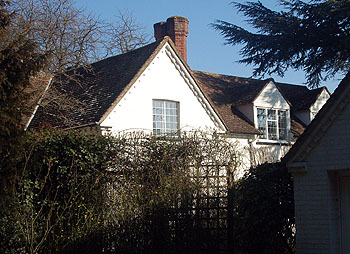Maze Cottage Oakley

Maze Cottage March 2011
Maze Cottage was listed by the former Department of Environment in August 1987 as Grade II, of special interest. The department dated the cottage to the late 18th or early 19th century. It was built as the lodge to Oakley House, itself built by Thomas Moore in 1749 and remodelled by Henry Holland about 1792. Maze Cottage may date to either of these events or to 1833 when the approach to the house through the park was altered. It is built of colour-washed brick and has an old clay tile roof. It was originally built in an L-plan with a left hand projecting gabled wing. A wing was added to the rear in the 20th century. The house comprises one storey and attics and has neo-Tudor paired hexagonal chimney stacks. The listing notes: "the building was named after an adjacent maze which has since been destroyed".
Oakley House and its estate was put up for sale by auction by the Duke of Bedford in October 1918. The sale particulars [AD1147/18] describe Maze Cottage and Reynes Cottage respectively as follows
The Entrance Lodge
Brick built and tiled, containing Four Rooms, COTTAGE adjoining with Three Rooms. Outbuildings - Barns, two Earth Closets and Washhouse in common.
A Stone and Tiled Cottage
near the latter, containing six Rooms.
In the event the Duke withdrew Oakley House and its outbuildings from the auction because he decided to sell privately to his cousin the 2nd Baron Ampthill. The Rating Valuation Act of 1925 specified that every building and piece of land in the country was to be assessed to determine the rates to be paid on it. Oakley, like most of the rest of the county was assessed in 1927. The valuer visiting Maze Cottage [DV1/C115/31] found it occupied by Mrs. Britton who paid no rent as she was the lodgekeeper. Her accommodation comprised two parlours and a scullery with three bedrooms above. Only a barn now stood outside and water came from the pump at Reynes Cottage. This house probably equates with the entrance lodge of four rooms and the adjoining cottage of three rooms in the 1918 particulars because the valuer in 1927 noted: "Was 2".